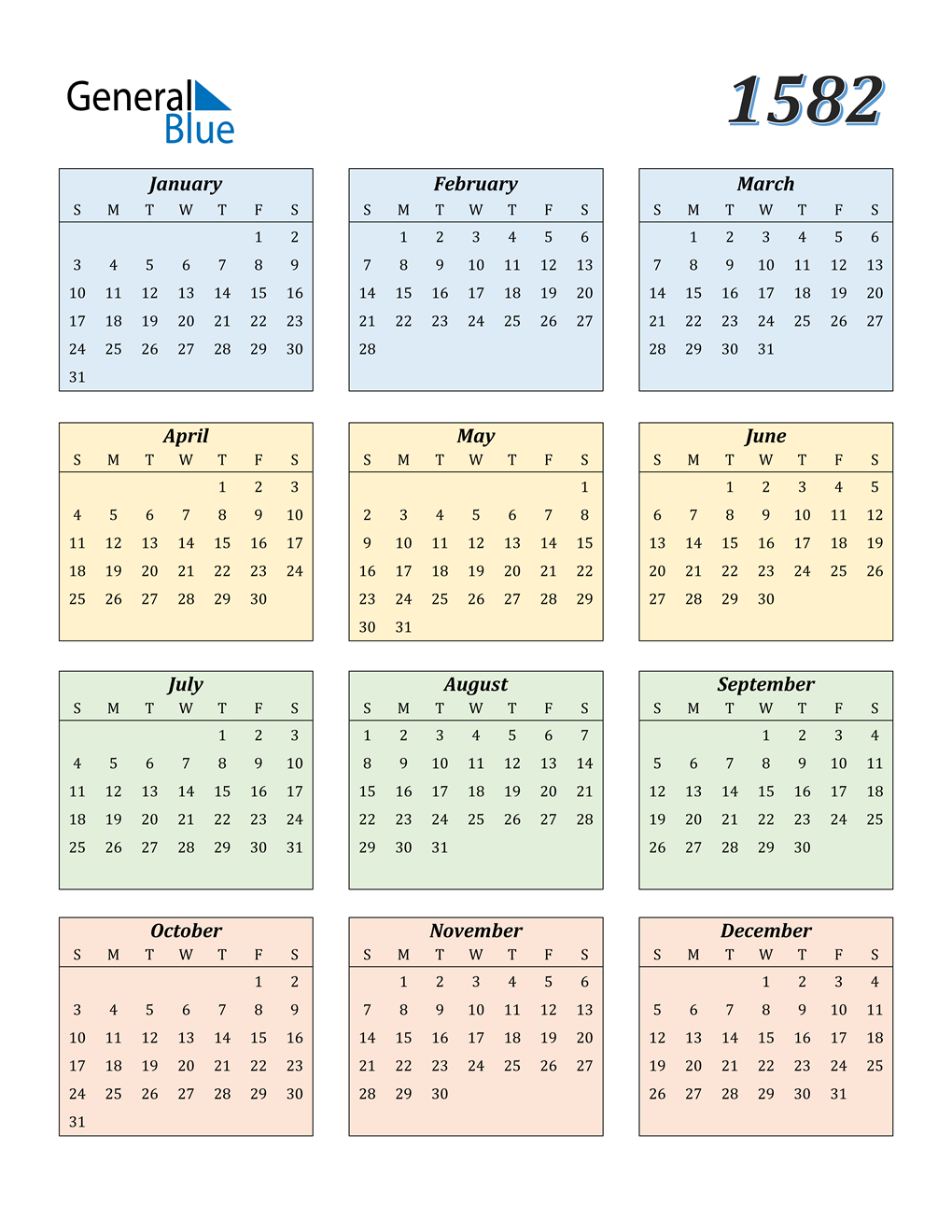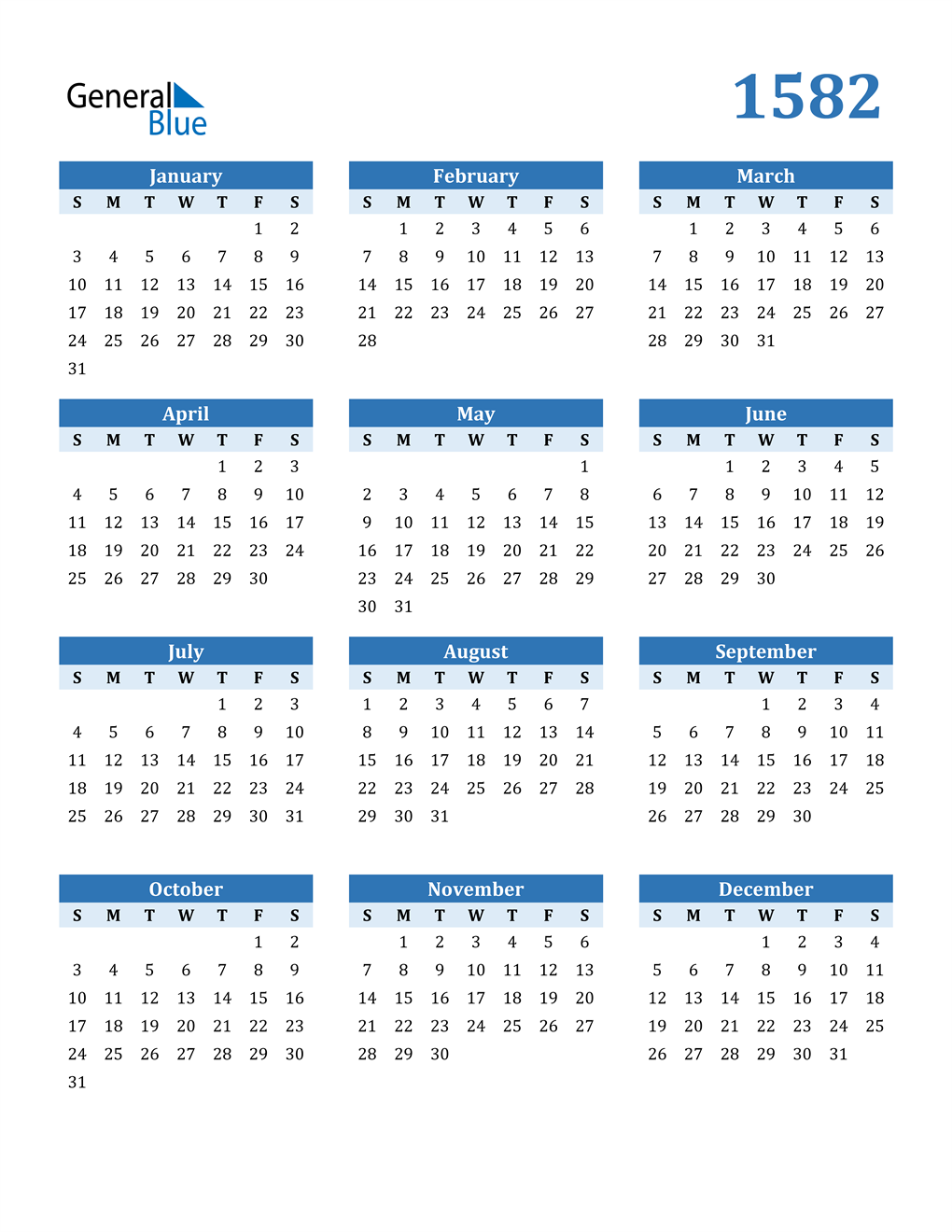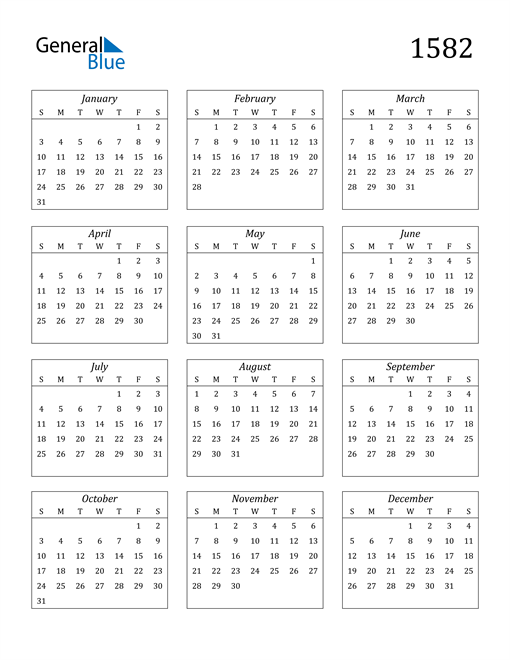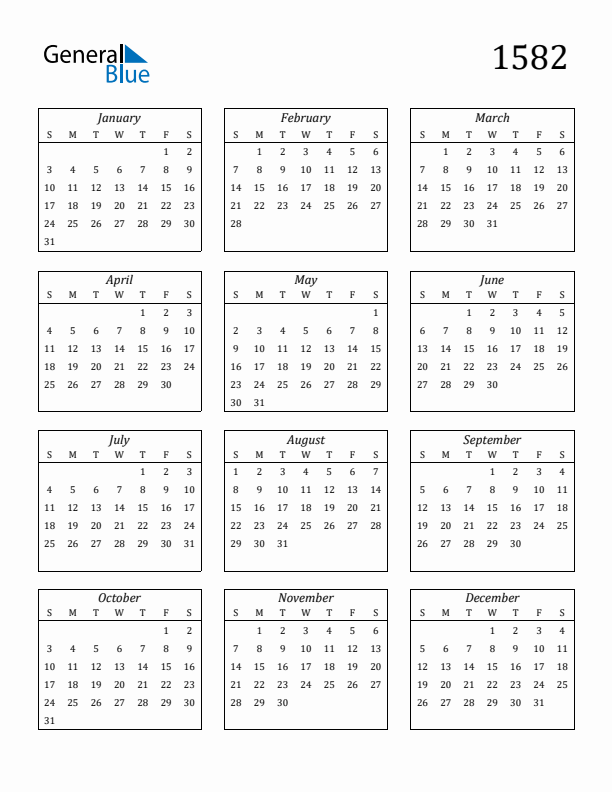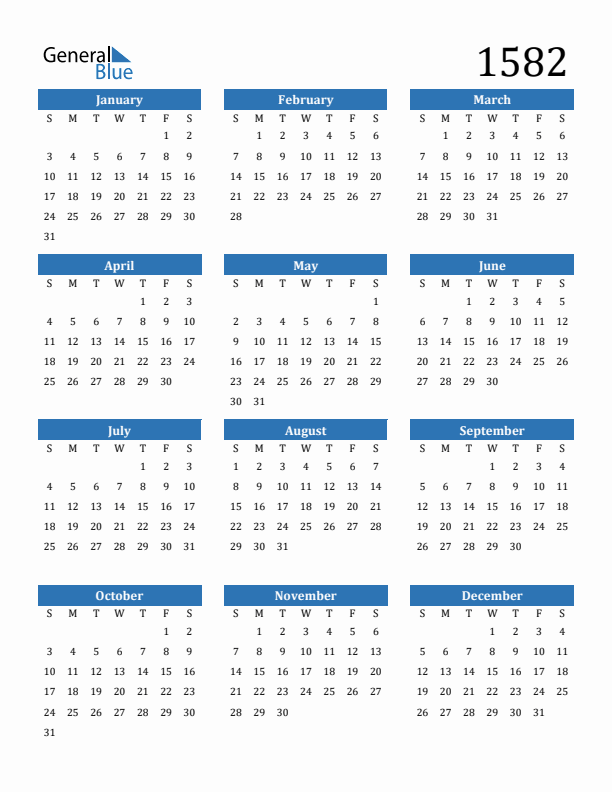Calendar Of 1582
Calendar Of 1582 - The calendar of october 1582 confused so many people on the internet. Then it is a leap year. The year is evenly divisible by 4; Web the gregorian calendar is the calendar used in most parts of the world. For dates on or after 15 october 1582, the gregorian calendar is used. If the year can be evenly divided by 100, it is not a leap year, unless; Local holidays are not listed, holidays are predicted based on current holidays but are likely to change. Web the calendar became the predominant calendar in the roman empire and subsequently most of the western world for more than 1,600 years until 1582, when pope gregory xiii promulgated a minor modification to reduce the average length of the year from 365.25 days to 365.2425 days and thus corrected the julian calendar's drift against the solar year. Web new france and new spain had adopted the new calendar in 1582. Web the most surreal part of implementing the new calendar came in october 1582, when 10 days were dropped from the calendar to bring the vernal equinox from march 11 back to march 21. Web the calendar became the predominant calendar in the roman empire and subsequently most of the western world for more than 1,600 years until 1582, when pope gregory xiii promulgated a minor modification to reduce the average length of the year from 365.25 days to 365.2425 days and thus corrected the julian calendar's drift against the solar year. Web internet. The reason for this was to bring the vernal equinox from march 11. Web the days between october 5 and october 14 never existed at all, and the day after october 4, 1582 was declared as october 15. The calendar of october 1582 confused so many people on the internet. Local holidays are not listed, holidays are predicted based on. Web the year 1582 has 52 calendar weeks. For dates on or after 15 october 1582, the gregorian calendar is used. Web new france and new spain had adopted the new calendar in 1582. Web 1582 ( mdlxxxii) was a common year starting on monday (link will display the full calendar) in the julian calendar, and a common year starting. Web this application assumes that the changeover from the julian calendar to the gregorian calendar occurred in october of 1582, according to the scheme instituted by pope gregory xiii. For dates on or after 15 october 1582, the gregorian calendar is used. 1582 begins on 01/01/1582 and ends on 31/12/1582. In the calendar, october 4 proceeded to october 15. The. Many wondered what happened to the days in between. Web it is named for pope gregory xiii, who issued the papal bull inter gravissimas in 1582, announcing calendar reforms for all of catholic christendom. 1582 begins on 01/01/1582 and ends on 31/12/1582. Web 1582 jan uary feb ruary mar ch apr il jun e jul y aug ust oct ober. Web year 1482 was a common year starting on tuesday (link will display the full calendar) of the julian calendar. The year is also evenly divisible by 400: Web during the period between 1582, when the first countries adopted the gregorian calendar, and 1923, when the last european country adopted it, it was often necessary to indicate the date of. Web it is named for pope gregory xiii, who issued the papal bull inter gravissimas in 1582, announcing calendar reforms for all of catholic christendom. The first calendar week in 1582 begins on monday, the 04/01/1582 and ends on sunday, the 10/01/1582. Web new france and new spain had adopted the new calendar in 1582. Alaska remained on the julian. The church had chosen october to avoid skipping any major christian festivals. Or select calendar sunday through saturday that is used in most north and south america. New formula for calculating leap years: The reason for this was to bring the vernal equinox from march 11. The reform altered the julian, or old style, system of leap years and, by. The year is evenly divisible by 4; Web calendar for 1582 year simple to use 1582 calendar displaying months and dates in the year. If the year can be evenly divided by 100, it is not a leap year, unless; Web the gregorian calendar is the calendar used in most parts of the world. The year 2082 is a common. Local holidays are not listed, holidays are predicted based on current holidays but are likely to change. The gregorian calendar modified the existing julian calendar, which julius caesar had introduced to the ancient roman republic in 46 bce. The year 2082 is a common year, with 365 days in total. Web the calendar became the predominant calendar in the roman. Web the gregorian calendar was first adopted in italy, poland, portugal, and spain in 1582, and included the following changes: Web new france and new spain had adopted the new calendar in 1582. The gregorian calendar modified the existing julian calendar, which julius caesar had introduced to the ancient roman republic in 46 bce. Web since the julian calendar had fallen ten days behind over the centuries, pope gregory xiii designated that october 4, 1582 would be officially followed by october 15, 1582. Web during the period between 1582, when the first countries adopted the gregorian calendar, and 1923, when the last european country adopted it, it was often necessary to indicate the date of some event in both the julian calendar and in the gregorian calendar. Then it is a leap year. Yearly calendar showing months for the. [1] [a] it was introduced on february 24 with a papal bull, and went into effect in october 1582 by pope gregory xiii as a modification of, and replacement for, the julian calendar. Or select calendar sunday through saturday that is used in most north and south america. The year 2082 is a common year, with 365 days in total. The gregorian calendar was applied in the british colonies in canada and the future united states east of the appalachian mountains in 1752. Web this application assumes that the changeover from the julian calendar to the gregorian calendar occurred in october of 1582, according to the scheme instituted by pope gregory xiii. 1582 begins on 01/01/1582 and ends on 31/12/1582. The calendar of october 1582 confused so many people on the internet. However, only five countries adopted the new calendar system that year—namely, italy, poland, portugal, spain, and most of france. Web the year 1582 has 52 calendar weeks. Web it is named for pope gregory xiii, who issued the papal bull inter gravissimas in 1582, announcing calendar reforms for all of catholic christendom. Web internet shocked after 10 days found missing from october of 1582. Specifically, for dates on or before 4 october 1582, the julian calendar is used; The first calendar week in 1582 begins on monday, the 04/01/1582 and ends on sunday, the 10/01/1582. The reform altered the julian, or old style, system of leap years and, by removing ten days from october 1582, adjusted the timing of the easter observance so that it better coincided. The calendar of october 1582 confused so many people on the internet. Web calendar for 1582 year simple to use 1582 calendar displaying months and dates in the year. Web 1582 ( mdlxxxii) was a common year starting on monday (link will display the full calendar) in the julian calendar, and a common year starting on friday (link will display full calendar) of the proleptic gregorian calendar. New formula for calculating leap years: Web it is named for pope gregory xiii, who issued the papal bull inter gravissimas in 1582, announcing calendar reforms for all of catholic christendom. The news of the calendar change was disseminated across europe. Web the most surreal part of implementing the new calendar came in october 1582, when 10 days were dropped from the calendar to bring the vernal equinox from march 11 back to march 21. Web new france and new spain had adopted the new calendar in 1582. First day of the week option allows to choose weeks monday through sunday which is commonly used in europe and asia. [1] [a] it was introduced on february 24 with a papal bull, and went into effect in october 1582 by pope gregory xiii as a modification of, and replacement for, the julian calendar. Web internet shocked after 10 days found missing from october of 1582. The year is evenly divisible by 4; The last calendar week in 1582 begins on monday, the 27.12.1582 and ends on sunday, the 02.01.1583. However, only five countries adopted the new calendar system that year—namely, italy, poland, portugal, spain, and most of france. If the year can be evenly divided by 100, it is not a leap year, unless;Fascinating Facts What Happened to the Calendars
1582 Calendar (PDF, Word, Excel)
The Gregorian calendar Calendar design, Yearly calendar, Blank
1582 Calendar (PDF, Word, Excel)
Free 1582 Calendars in PDF, Word, Excel
The calendar in October 1582 lost 11 days during the conversion from
1582 Calendar (PDF, Word, Excel)
Gregorian Calendar 1582 High Resolution Stock Photography and Images
Free 1582 Calendars in PDF, Word, Excel
1582 Calendar (PDF, Word, Excel)
Web The Gregorian Calendar Is The Calendar Used In Most Parts Of The World.
Or Select Calendar Sunday Through Saturday That Is Used In Most North And South America.
The Gregorian Calendar Was Instituted By Pope Gregory Xiii In 1582 And Quickly Adopted By Much Of Catholic, But Not Protestant, Europe.
For Dates On Or After 15 October 1582, The Gregorian Calendar Is Used.
Related Post:


